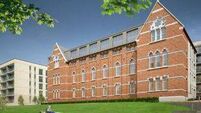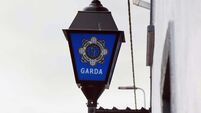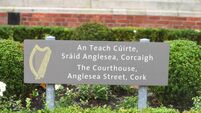Murder trial hears 'combination of all the stab and slash injuries' led to Macroom man's death

Sixty-one-year-old Michael Foley suffered 11 stab wounds, 19 slashes and multiple bruises and lacerations, the pathologist told the jury at the murder trial in Cork on Wednesday. File photo
The 61-year-old man whose dead body was found in his kitchen in a pool of blood, suffered 11 stab wounds, 19 slashes and multiple bruises and lacerations, the pathologist told the jury at the murder trial in Cork on Wednesday.
Dr Margaret Bolster, assistant state pathologist, told Ms Justice Siobhán Lankford and the nine men and three women of the jury in the Macroom murder trial that the injuries could have been inflicted by the long carving knife which was shown to her, or by a knife similar to this.
The knife, which was shown by Detective Garda Muireann Byrne to the pathologist, was found in a black bag in the cargo hold of a bus on which the two accused travelled from Macroom to Cork City, the day after the deceased was last seen alive.
32-year-old Daniel Hourigan who is originally from Farranree in Cork City and 32-year-old Linda O'Flynn, who is originally from the Hollyhill area of Cork City, both deny the murder of 61-year-old Michael Foley at his home in Macroom between January 31 and February 1, 2024.
Each defendant effectively blames the other. To the murder charge, each of them replied not guilty to murder but guilty of impeding the prosecution of another person.
Dr Bolster gave evidence of the wounds and injuries that she found on Mr Foley’s body when she conducted a post-mortem examination on his remains at Cork University Hospital after Michael Foley was found dead in his home.
Dr Bolster said the wounds that she found on Mr Foley included 11 stab wounds and 19 slash or incision wounds. One of the stab wounds pierced Mr Foley’s right lung leading to its collapse and one of the slash wounds penetrated his skull and caused the loss of a lot of blood.
Dr Bolster said many of the slash and stab wounds to Mr Foley’s hands and arms were of a defensive nature while she also found evidence of approximately 30 bruises and lacerations all over his body, including several to his legs, but she found no evidence of any bones being broken.
“The slash wounds to the head would cause major bleeding and a slash wound to the head can alone cause death, but there is no evidence that a slash wound alone caused death in this case and it was a combination of all the stab and slash injuries that led to death,” she said.
Dr Bolster also said she took blood samples from Mr Foley’s body at post-mortem and toxicology tests revealed that he had a blood alcohol concentration of 227 mgs of alcohol per 100 mls of blood which was over four times the legal driving limit.
Cross-examined by Ray Boland, defence counsel for Mr Hourigan, Dr Bolster agreed that an alcohol concentration level of 227 mgs of alcohol per 100 mls of blood would impact on a person’s ability to defend themselves, impairing both their judgement and their co-ordination.
Donal O’Sullivan, senior counsel for Linda O’Flynn, did not cross-examine the witness.
Fingerprint expert, Dr Craig Mullen of Forensic Science Ireland, confirmed that a palm print found on a doorframe at Mr Foley’s flat matched Mr Hourigan’s left palm print. He also said that a fingerprint found on a mug matched a print from Ms O’Flynn’s right ring finger.
The trial continues.












